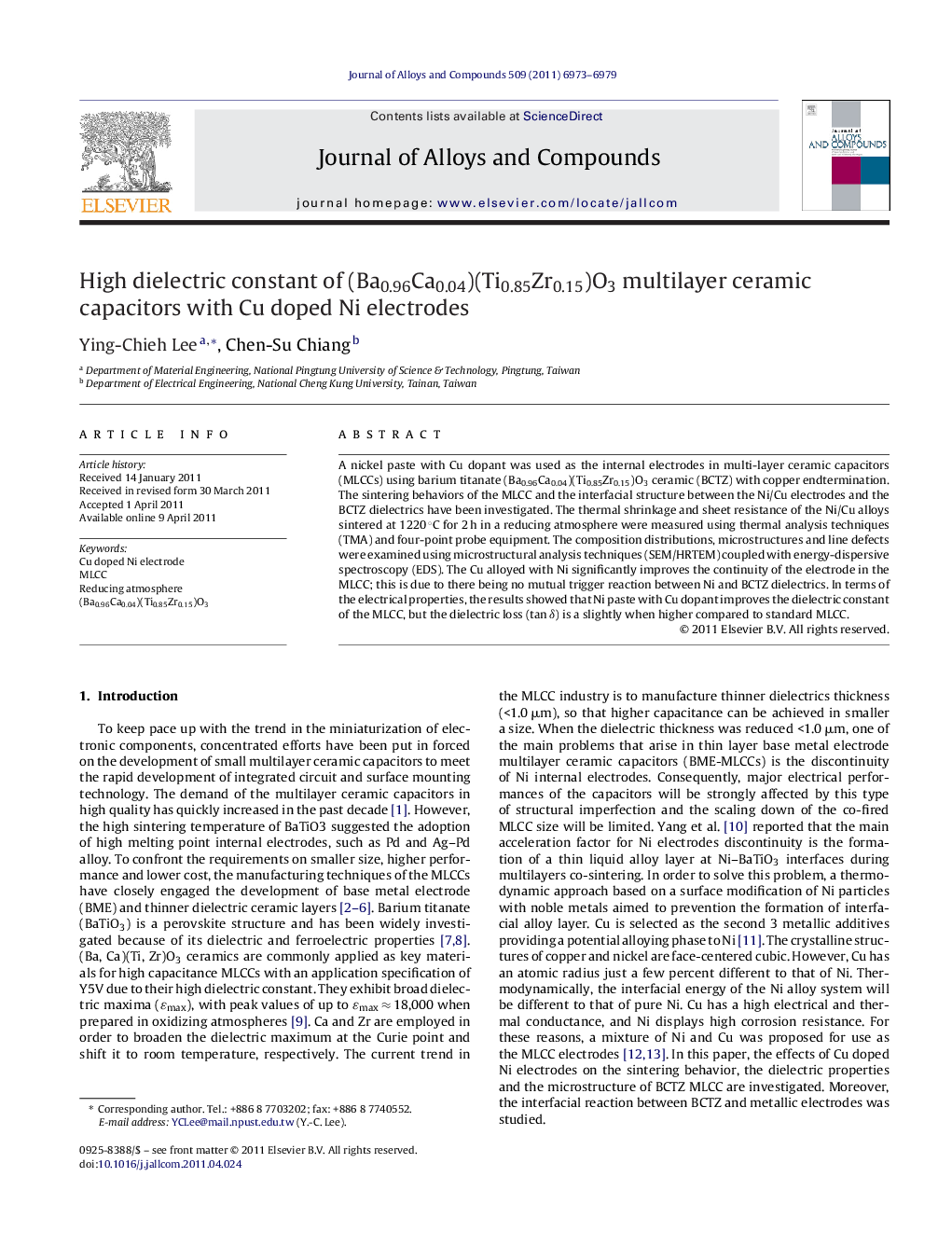| کد مقاله | کد نشریه | سال انتشار | مقاله انگلیسی | نسخه تمام متن |
|---|---|---|---|---|
| 1617258 | 1005681 | 2011 | 7 صفحه PDF | دانلود رایگان |

A nickel paste with Cu dopant was used as the internal electrodes in multi-layer ceramic capacitors (MLCCs) using barium titanate (Ba0.96Ca0.04)(Ti0.85Zr0.15)O3 ceramic (BCTZ) with copper endtermination. The sintering behaviors of the MLCC and the interfacial structure between the Ni/Cu electrodes and the BCTZ dielectrics have been investigated. The thermal shrinkage and sheet resistance of the Ni/Cu alloys sintered at 1220 °C for 2 h in a reducing atmosphere were measured using thermal analysis techniques (TMA) and four-point probe equipment. The composition distributions, microstructures and line defects were examined using microstructural analysis techniques (SEM/HRTEM) coupled with energy-dispersive spectroscopy (EDS). The Cu alloyed with Ni significantly improves the continuity of the electrode in the MLCC; this is due to there being no mutual trigger reaction between Ni and BCTZ dielectrics. In terms of the electrical properties, the results showed that Ni paste with Cu dopant improves the dielectric constant of the MLCC, but the dielectric loss (tan δ) is a slightly when higher compared to standard MLCC.
► Characteristic evaluation for Cu doped Ni thick films: When Cu was doped in Ni paste, the shrinkage of Ni thick films was decreased obviously. The addition of Cu retards the shrinkage of the Ni thick films, leading to better interfacial matching between the Ni film and the Al2O3 substrate.
► Effect of Cu doped Ni electrodes on the microstructures of BCTZ MLCC: the continuity of the internal electrodes in the MLCC was about 88% with a lay-down of approximately 0.6 mg/cm2. However, the continuity of internal electrodes in commercial MLCCs is below 80% in general with particular reference to the Y5V-1206 MLCCs rated 1 μF. The sample shows the presence of many dislocations in the interface, which is between BCTZ and the metal electrode. This phenomenon can be explained by lattice distortion, which comes about as Cu substitutes for Ti, creating lattice strain and oxygen vacancies. Dislocations are created in the lattice during the solidification of crystalline solids.
► Effect of Cu doped Ni electrodes on the dielectric properties of BCTZ MLCC: the temperature coefficient of capacitance (TCC): for samples with of 0, 1.0, and 3.0 wt.% Cu dopant, the Curie temperatures were 0 °C, 19.7 °C, and 14.3 °C, respectively. The Curie point shifted to a higher temperature with added Cu dopant. The ɛr value of the BCTZ MLCC without the addition of Cu sintered at 1220 °C was very low (∼10,000). The dielectric constants of the BCTZ MLCC sintered at 1220 °C are 2,5216 and 2,4098 when doped with 1 wt.% and 3 wt.% Cu in Ni paste, respectively.
Journal: Journal of Alloys and Compounds - Volume 509, Issue 24, 16 June 2011, Pages 6973–6979